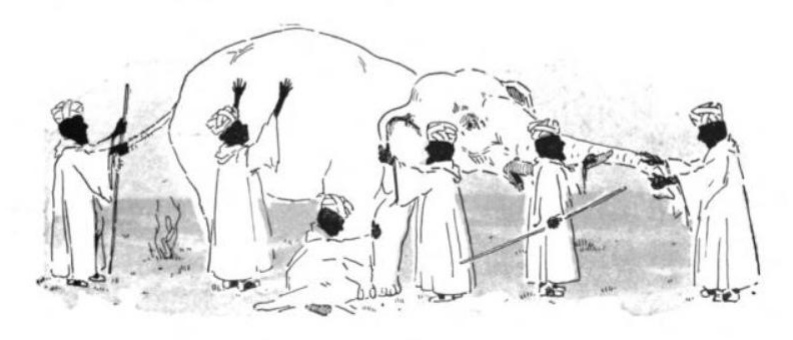
Every project I have worked on as a UX specialist has been a team project, whether it’s a team made up of specialists from a variety of creative and technical disciplines, a team of clients or product managers working with creative and technical experts, a combination of those, or crazy mixtures of people trying to solve problems and/or create solutions. I often use the parable of the blind men and the elephant (illustrated above) as a metaphor for the dynamics of cross-functional teams working on digital experiences.
According to the parable, six blind men encounter an elephant, and each man feels a different part of the elephant. The man with the trunk says, it’s a firehose! The man with the tusks says, it’s a spear! And so on. Each one focuses on a specific aspect of the elephant, just as digital specialists focus on their area of expertise when approaching a digital experience — the visual design, the writing, the brand, the development platform, the schedule, the budget, etc.
Each specialist needs all the others to see the whole “elephant.”
For me, the collaboration of empowered specialists is magical: it’s what makes a good idea great, what makes a job a calling, what makes that calling fun. The only time I do not (usually) collaborate with team members is when I’m sitting at my computer making wireframes, diagrams, specs, etc., to share with my team. The work I do at my computer is either based on copious notes and sketches from collaborative sessions, or it’s working out my own ideas to share with my team, or it’s answering questions my team needs my brain to work out. I do not see myself as a one-man show.
Collaboration is such an integral part of what I do, it’s not easy to come up with “examples” of it . . . but I thought I’d give it a shot.
Collaborating with Analytics
It’s really fun to work with analytics specialists. I began my career working with a company that had developed custom analytics that allowed them to view website traffic real time. I sat with the executives and creative leads as they reviewed reports and analyzed the visual designs to diagnose problems. It was amazing, and from then on I have believed in analytics as an important tool for optimizing UX.